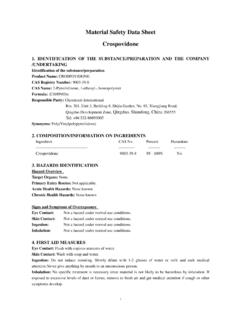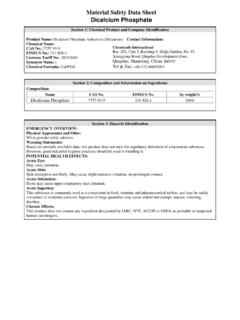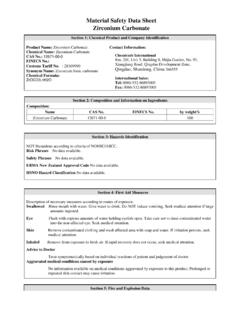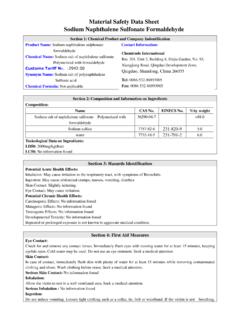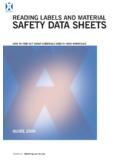Transcription of Material Safety Data Sheet Corn Starch - trade-chem.com
1 Section 1: Chemical Product and Company Identification Product Name: corn Starch Contact Information: Chemical Name: None CAS No.: 9005-25-8 EINECS No.: 232-679-6 Customs Tariff No : 211081200 Synonym Name: Chemical Formula: (C6H10O5)2 Section 2: Composition and Information on Ingredients Composition: Name CAS No. EINECS No. by weight% corn Starch 9005-25-8 232-679-6 100% Toxicological data on Ingredients: Not applicable. Section 5: Fire and Explosion data Section 3: Hazards Identification Potential Acute Health Effects: Slightly hazardous in case of skin contact (irritant), of eye contact (irritant), of ingestion, of inhalation. Potential Chronic Health Effects: CARCINOGENIC EFFECTS: A4 (Not classifiable for human or animal.) by ACGIH. MUTAGENIC EFFECTS: Not available. TERATOGENIC EFFECTS: Not available. DEVELOPMENTAL TOXICITY: Not available. Repeated or prolonged exposure is not known to aggravate medical condition.
2 Section 4: First Aid Measures Eye Contact: Check for and remove any contact lenses. In case of contact, immediately flush eyes with plenty of water for at least 15 minutes. Get medical attention if irritation occurs. Skin Contact: Wash with soap and water. Cover the irritated skin with an emollient. Get medical attention if irritation develops. Serious Skin Contact: Not available. Inhalation: If inhaled, remove to fresh air. If not breathing, give artificial respiration. If breathing is difficult, give oxygen. Get medical attention. Serious Inhalation: Not available. Ingestion: Do NOT induce vomiting unless directed to do so by medical personnel. Never give anything by mouth to an unconscious person. If large quantities of this Material are swallowed, call a physician immediately. Loosen tight clothing such as a collar, tie, belt or waistband. Serious Ingestion: Not available. Chemtrade International Rm.
3 201, Unit 3, Building 8, Shijia Garden, No. 93, Xiangjiang Road, Qingdao Development Zone, Qingdao, Shandong, China 266555 International Sales: Tel: 0086-532-86893005 Fax: 0086-532-86893005 Material Safety data Sheet corn Starch Flammability of the Product: May be combustible at high temperature. Auto-Ignition Temperature: Not available. Flash Points: Not available. Flammable Limits: Not available. Products of Combustion: Not available. Fire Hazards in Presence of Various Substances: Slightly flammable to flammable in presence of heat. Explosion Hazards in Presence of Various Substances: Risks of explosion of the product in presence of mechanical impact: Not available. Risks of explosion of the product in presence of static discharge: Not available. Fire Fighting Media and Instructions: SMALL FIRE: Use DRY chemical powder. LARGE FIRE: Use water spray, fog or foam. Do not use water jet. Special Remarks on Fire Hazards: Not available.
4 Special Remarks on Explosion Hazards: Not available. Section 6: Accidental Release Measures Small Spill: Use appropriate tools to put the spilled solid in a convenient waste disposal container. Finish cleaning by spreading water on the contaminated surface and dispose of according to local and regional authority requirements. Large Spill: Use a shovel to put the Material into a convenient waste disposal container. Finish cleaning by spreading water on the contaminated surface and allow to evacuate through the sanitary system. Be careful that the product is not present at a concentration level above TLV. Check TLV on the MSDS and with local authorities. Section 7: Handling and Storage Precautions: Keep away from heat. Keep away from sources of ignition. Empty containers pose a fire risk, evaporate the residue under a fume hood. Ground all equipment containing Material . Do not breathe dust. Keep away from incompatibles such as oxidizing agents.
5 Storage: Keep container tightly closed. Keep container in a cool, well-ventilated area. Do not store above 23 C ( F). Section 8: Exposure Controls/Personal Protection Engineering Controls: Use process enclosures, local exhaust ventilation, or other engineering controls to keep airborne levels below recommended exposure limits. If user operations generate dust, fume or mist, use ventilation to keep exposure to airborne contaminants below the exposure limit. Personal Protection: Safety glasses. Lab coat. Dust respirator. Be sure to use an approved/certified respirator or equivalent. Gloves. Personal Protection in Case of a Large Spill: Splash goggles. Full suit. Dust respirator. Boots. Gloves. A self contained breathing apparatus should be used to avoid inhalation of the product. Suggested protective clothing might not be sufficient; consult a specialist BEFORE handling this product. Exposure Limits: TWA: 10 (mg/m3) from ACGIH (TLV) [United States] [1999] Inhalation Total.
6 TWA: 10 (mg/m3) [Canada] Inhalation Total. TWA: 10 (mg/m3) from NIOSH Inhalation Total. TWA: 5 (mg/m3) from NIOSH Inhalation Respirable. TWA: 15 (mg/m3) from OSHA (PEL) [United States] Inhalation Total. TWA: 5 (mg/m3) from OSHA (PEL) [United States] Inhalation Respirable. Consult local authorities for acceptable exposure limits. Section 9: Physical and Chemical Properties Physical state and appearance: Solid. Odor: Not available. Taste: Not available. Molecular Weight: Not available. Color: White. pH (1% soln/water): Not applicable. Boiling Point: Not available. Melting Point: Decomposes. Critical Temperature: Not available. Specific Gravity: (Water = 1) Vapor Pressure: Not applicable. Vapor Density: Not available. Volatility: Not available. Odor Threshold: Not available. Water/Oil Dist. Coeff.: Not available. Ionicity (in Water): Not available. Dispersion Properties: Not available. Solubility: Insoluble in cold water, hot water.
7 Section 10: Stability and Reactivity data Stability: The product is stable. Instability Temperature: Not available. Conditions of Instability: Excess heat, incompatible materials. Incompatibility with various substances: Reactive with oxidizing agents. Corrosivity: Not available. Special Remarks on Reactivity: Not available. Special Remarks on Corrosivity: Not available. Polymerization: Will not occur. Section 11: Toxicological Information Routes of Entry: Inhalation. Ingestion. Toxicity to Animals: LD50: Not available. LC50: Not available. Chronic Effects on Humans: CARCINOGENIC EFFECTS: A4 (Not classifiable for human or animal.) by ACGIH. Other Toxic Effects on Humans: Slightly hazardous in case of skin contact (irritant), of ingestion, of inhalation. Special Remarks on Toxicity to Animals: Not available. Special Remarks on Chronic Effects on Humans: Not available. Special Remarks on other Toxic Effects on Humans: Acute Potential Health Effects: Skin: May cause mild skin irritation.
8 Low hazard for usual industrial handling. Eyes: Dust may cause mechanical irritation. Inhalation: Excessive inhalation may cause minor respiratory irritation. Ingestion: A low hazard for usual industrial handling Chronic Potential Health Effects: no information. Section 12: Ecological Information Ecotoxicity: Not available. BOD5 and COD: Not available. Products of Biodegradation: Possibly hazardous short term degradation products are not likely. However, long term degradation products may arise. Toxicity of the Products of Biodegradation: Not available. Special Remarks on the Products of Biodegradation: Not available. Section 13: Disposal Considerations Waste Disposal: Waste must be disposed of in accordance with federal, state and local environmental control regulations. Section 14: Transport Information DOT Classification: Not a DOT controlled Material (United States). Identification: Not applicable.
9 Special Provisions for Transport: Not applicable. Section 15: Other Regulatory Information Federal and State Regulations: Rhode Island RTK hazardous substances: Starch Pennsylvania RTK: Starch Minnesota: Starch Massachusetts RTK: Starch Tennessee: Starch TSCA 8(b) inventory: Starch Other Regulations: EINECS: This product is on the European Inventory of Existing Commercial Chemical Substances. Other Classifications: WHMIS (Canada): Not controlled under WHMIS (Canada). DSCL (EEC): This product is not classified according to the EU regulations. S24/25- Avoid contact with skin and eyes. HMIS ( ): Health Hazard: 1 Fire Hazard: 1 Reactivity: 0 Personal Protection: E National Fire Protection Association ( ): Health: 1 Flammability: 1 Reactivity: 0 Specific hazard: Protective Equipment: Gloves. Lab coat. Dust respirator. Be sure to use an approved/certified respirator or equivalent. Safety glasses. Section 16: Other Information The information above is based on current knowledge and experience.
10 The purpose of this Safety data Sheet is to describe the products in terms of their Safety requirements. The above details do not imply any guarantee concerning composition, properties or performance. Users should make their own investigations to determine the suitability of the information for their particular purposes. Revised version dated: June 1, 2008
